Caves and Rock Shelters on the North coast of Spain
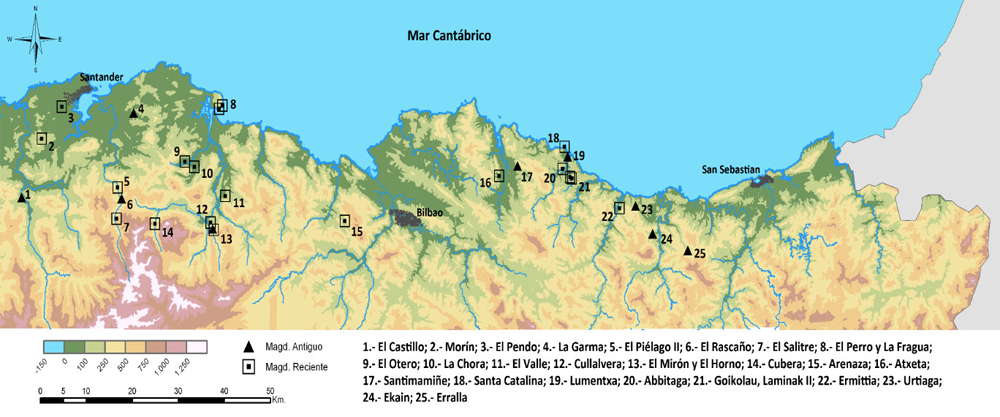 Archeological sites on the North coast of Spain
Photo: Moreno (2010)
Archeological sites on the North coast of Spain
Photo: Moreno (2010)
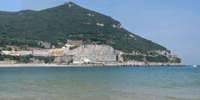
Monte Buciero has around 20 caves and small abris or rock shelters. Human occupation is known in at least seven of these caves. Engravings have been found in two of them - Peña del Perro and Cueva de San Carlos, also known as Cueva del Fortín.
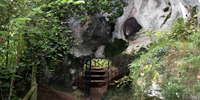 El Buxu Cave was discovered by chance in December 1916 by Cesáreo Cardin, an habitual collaborator in the archaeological digs of Hugo Obermaier and Conde de la Vega del Sella. The entrance is formed by an outer vestibule six metres wide and five metres deep, facing south-west. The original rock-shelter, however, was much larger, as is shown by the presence of numerous blocks of limestone which have collapsed from the roof, and the remains of a former floor, partially eroded away. This former rock-shelter would have faced south, situated 300 metres above present-day sea level, and 25 metres above the valley floor.
El Buxu Cave was discovered by chance in December 1916 by Cesáreo Cardin, an habitual collaborator in the archaeological digs of Hugo Obermaier and Conde de la Vega del Sella. The entrance is formed by an outer vestibule six metres wide and five metres deep, facing south-west. The original rock-shelter, however, was much larger, as is shown by the presence of numerous blocks of limestone which have collapsed from the roof, and the remains of a former floor, partially eroded away. This former rock-shelter would have faced south, situated 300 metres above present-day sea level, and 25 metres above the valley floor.
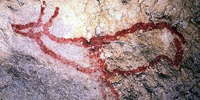 Covalanas cave in Cantabria, Spain, was first discovered to have art work in 1903. It is situated on the South-Western hillside of Pando mountain, near the cave of el Míron. Although the entrance is not huge, access is easy. From the entrance two galleries continue, though only one of them has palaeolithic decoration. In a deep zone of the gallery, and in a space less than 12 metres in length, the largest group of art in the cave is located. It has 22 figures, of which 18 are hinds , a characteristic animal in the Cantabrian decorated caves, as well as a horse, a reindeer and an aurochs. The paintings are between 20 000 and 14 400 years old.
Covalanas cave in Cantabria, Spain, was first discovered to have art work in 1903. It is situated on the South-Western hillside of Pando mountain, near the cave of el Míron. Although the entrance is not huge, access is easy. From the entrance two galleries continue, though only one of them has palaeolithic decoration. In a deep zone of the gallery, and in a space less than 12 metres in length, the largest group of art in the cave is located. It has 22 figures, of which 18 are hinds , a characteristic animal in the Cantabrian decorated caves, as well as a horse, a reindeer and an aurochs. The paintings are between 20 000 and 14 400 years old.
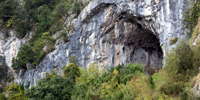 The archaeological cave site of El Mirón is located in the Rio Asón valley of eastern Cantabria, Spain. The cave opening is about 260 metres above sea level, and the cave opening is about 13 metres high, 8-16 metres wide, and 120 metres deep. El Mirón is remarkable for its long occupation history and thus for its long unbroken sequence of history and prehistory of Cantabria, Spain. The site includes human occupations between the Middle Paleolithic (ca 41 000 years ago) to AD 1400, including Mousterian, Early Upper Paleolithic, Solutrean, Magdalenian, Azilian, Mesolithic, Neolithic, Chalcolithic, and Bronze Age deposits.
The archaeological cave site of El Mirón is located in the Rio Asón valley of eastern Cantabria, Spain. The cave opening is about 260 metres above sea level, and the cave opening is about 13 metres high, 8-16 metres wide, and 120 metres deep. El Mirón is remarkable for its long occupation history and thus for its long unbroken sequence of history and prehistory of Cantabria, Spain. The site includes human occupations between the Middle Paleolithic (ca 41 000 years ago) to AD 1400, including Mousterian, Early Upper Paleolithic, Solutrean, Magdalenian, Azilian, Mesolithic, Neolithic, Chalcolithic, and Bronze Age deposits.
References
-
Moreno, A., 2010: Patrones de asentamiento y ocupación del territorio en el Cantábrico Oriental al final del Pleistoceno, Tesis Doctoral, Universidad de Cantabria, 2010.
 Back to Archaeological Sites
Back to Archaeological Sites

 Back to Archaeological Sites
Back to Archaeological Sites

 El Buxu Cave was discovered by chance in December 1916 by Cesáreo Cardin, an habitual collaborator in the archaeological digs of Hugo Obermaier and Conde de la Vega del Sella. The entrance is formed by an outer vestibule six metres wide and five metres deep, facing south-west. The original rock-shelter, however, was much larger, as is shown by the presence of numerous blocks of limestone which have collapsed from the roof, and the remains of a former floor, partially eroded away. This former rock-shelter would have faced south, situated 300 metres above present-day sea level, and 25 metres above the valley floor.
El Buxu Cave was discovered by chance in December 1916 by Cesáreo Cardin, an habitual collaborator in the archaeological digs of Hugo Obermaier and Conde de la Vega del Sella. The entrance is formed by an outer vestibule six metres wide and five metres deep, facing south-west. The original rock-shelter, however, was much larger, as is shown by the presence of numerous blocks of limestone which have collapsed from the roof, and the remains of a former floor, partially eroded away. This former rock-shelter would have faced south, situated 300 metres above present-day sea level, and 25 metres above the valley floor.
 Covalanas cave in Cantabria, Spain, was first discovered to have art work in 1903. It is situated on the South-Western hillside of Pando mountain, near the cave of el Míron. Although the entrance is not huge, access is easy. From the entrance two galleries continue, though only one of them has palaeolithic decoration. In a deep zone of the gallery, and in a space less than 12 metres in length, the largest group of art in the cave is located. It has 22 figures, of which 18 are hinds , a characteristic animal in the Cantabrian decorated caves, as well as a horse, a reindeer and an aurochs. The paintings are between 20 000 and 14 400 years old.
Covalanas cave in Cantabria, Spain, was first discovered to have art work in 1903. It is situated on the South-Western hillside of Pando mountain, near the cave of el Míron. Although the entrance is not huge, access is easy. From the entrance two galleries continue, though only one of them has palaeolithic decoration. In a deep zone of the gallery, and in a space less than 12 metres in length, the largest group of art in the cave is located. It has 22 figures, of which 18 are hinds , a characteristic animal in the Cantabrian decorated caves, as well as a horse, a reindeer and an aurochs. The paintings are between 20 000 and 14 400 years old. The archaeological cave site of El Mirón is located in the Rio Asón valley of eastern Cantabria, Spain. The cave opening is about 260 metres above sea level, and the cave opening is about 13 metres high, 8-16 metres wide, and 120 metres deep. El Mirón is remarkable for its long occupation history and thus for its long unbroken sequence of history and prehistory of Cantabria, Spain. The site includes human occupations between the Middle Paleolithic (ca 41 000 years ago) to AD 1400, including Mousterian, Early Upper Paleolithic, Solutrean, Magdalenian, Azilian, Mesolithic, Neolithic, Chalcolithic, and Bronze Age deposits.
The archaeological cave site of El Mirón is located in the Rio Asón valley of eastern Cantabria, Spain. The cave opening is about 260 metres above sea level, and the cave opening is about 13 metres high, 8-16 metres wide, and 120 metres deep. El Mirón is remarkable for its long occupation history and thus for its long unbroken sequence of history and prehistory of Cantabria, Spain. The site includes human occupations between the Middle Paleolithic (ca 41 000 years ago) to AD 1400, including Mousterian, Early Upper Paleolithic, Solutrean, Magdalenian, Azilian, Mesolithic, Neolithic, Chalcolithic, and Bronze Age deposits.